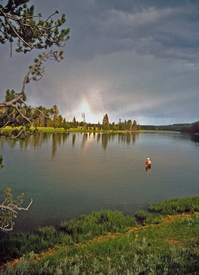
When we started our business in 1976 the cutthroat trout fishery in the Yellowstone River downstream from Yellowstone Lake was phenomenal. While there is no “sure thing” in fly fishing, a trip to the Yellowstone River on the traditional July 15th opening day was a sure thing. It was not only possible but probable that an angler with a tiny degree of fly fishing experience could hook and land a couple of dozen seventeen inch cutthroats in a day of fishing. Experienced anglers caught so many that they quickly got tired and bored with this fishing.
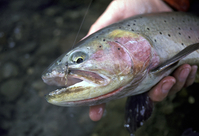
I heard reports of 20 inch trout landed from the Upper Yellowstone but I never saw any. Virtually all of the trout I saw were cookie-cutter 17 inch trout. Most of them were beautifully colored, slender and sluggish fighters. In fact, some of us called them Twisters as a result of their poor fighting qualities. Yet these trout were tailor-made for less experienced anglers because they ate virtually anything you threw at them, you didn’t need a perfect presentation and they were easy to land. One reason for this was the fish were very hungry and they were in relatively poor condition after spawning. A good portion of the trout in the Yellowstone River were migratory from Yellowstone Lake.
By the end of the season the cutthroats in the Yellowstone River weren’t so gullible. Not long after our marriage I took my new bride Sheralee to the Yellowstone so she could experience catching some nice trout. I assured her she would land dozens of nice trout. Boy, was that a mistake! While we could see fish rising everywhere to blue winged olive mayflies, the only trout we could interest lifted to spurn all of our dry flies. I finally went to 7X, something I almost never do, to land the only trout of the day. Sheralee had a great time as she always does but I was bummed. It was only in later years that I began to understand the complexities of this Yellowstone fishery.
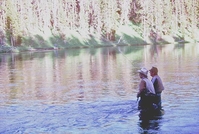
By the late 1990s we noticed things were starting to change on the Yellowstone River. By the end of the decade the fishery had really dropped off. In 1994 lake trout were discovered in Yellowstone Lake. It is likely that these predatory, non-native trout had been living in the lake for 20 years or more. There are several theories as to how they got there but the important thing to remember is they have the potential to decimate the Yellowstone Lake cutthroat trout population. Research indicates that a single lake trout can consume at least 41 cutthroat trout each year. That may not seem like much but as these non-native predators continued to multiply the cutthroat fishery declined accordingly.
By the beginning of the 21st century I stopped fishing the Yellowstone River. We also stopped taking clients there. It wasn’t worth the 2-hour drive through the traffic of the park to catch two or three cutthroat trout that didn’t fight. I heard reports that the quality of the fish had improved but I didn’t follow up. It wasn’t until I volunteered to join my old buddy Bob Jacklin to donate a couple of days guided fishing to the Yellowstone Association for their fund-raising efforts. Bob and I roomed together at their facility in Gardiner.
The first day I took 3 guys to wade Lower Slough Creek near the confluence with the Lamar River while Bob took a nice couple to the Upper Lamar River. At the end of the day everyone had landed some nice fish. The second day Bob and I switched clients. My people wanted to go back to the Lamar which worked for me. Meanwhile Bob offered to take his group to the Yellowstone River. I marveled at Bob’s courage. Trying to get three guys into trout wading the Yellowstone River sounded like a daunting job.
The folks I took had great fishing on the Lamar. They were very accomplished anglers and had no trouble catching several dozen nice cutthroat trout feeding on the surface on Green Drakes. I was a bit worried about upstaging Bob’s group when we got back. That definitely wasn’t the case. All of the members of his group landed at least one fish 23 inches or better. I was totally amazed. Some of the photos of the trout they landed almost took my breath away. While they had to hunt for them and they didn’t catch many, the big trout they landed overshadowed anything else. I envied them for spending a day with Bob Jacklin, who probably knows the Yellowstone River better than anybody.
The following season some of our guides started taking our guests back to the Yellowstone and they caught some very large fish. Sometimes we get too wrapped up with the length of a fish. A 16” trout from the Yellowstone River is really a toad. Not only that, they fight like there is no tomorrow. I had good intentions to get back to the Yellowstone but it never happened.
Last fall two of our former guides, A J Campbell and Tim Stamm went back to their old stomping grounds on the Yellowstone River. They fished some of the spots they once treasured as guides. They didn’t catch a lot of fish but the fish they caught were impressive. Best of all the fish battled to the end. It was enough for me, I had to get back to the Yellowstone.
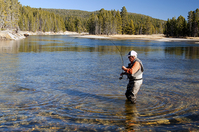
For one reason or another I couldn’t seem to make happen. Finally in mid-October Sheralee and I made the drive north. We passed dozens of anglers working the Madison and we saw several nice fish landed. It was hard to keep driving. We were surprised at the traffic in the park. There were lots of people enjoying our Indian Summer. We drove up the Yellowstone through the closed area in Hayden Valley until we arrived at our fishing destination in early afternoon. It was too late in the day for hatches so I grabbed my streamer rod and hiked to the water. Sheralee didn’t feel like chucking streamers so she took the camera.
I carefully worked the water for about an hour without a strike. One thing I like about streamer fishing is you don’t have to think about what you’re doing all of the time. You just cast, mend, and retrieve, and methodically work the fly as it drifts through the run like a crippled baitfish. This gave me time to watch the surroundings which isn’t a bad idea when fishing in the park. There were two enormous bull bison pushing each other around across the river. I was comfortable as long as they focused on each other.
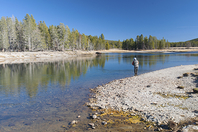
I walked a little further up the river to another promising pool. I was encouraged when I saw a very large fish break the surface at the head of the run. Unfortunately the bison had made their way above and into the edge of the water making the head of the run a potential hazardous problem so I opted to fish the lower end of the run. I was totally focused on the bison when the line pulled tight. The fish was heavy as it drove downstream through a long arching run. I backed out to shallower water where I could follow the trout. Even at that it managed to take some of the backing. It was hard to remind myself that I was attached to a cutthroat trout. Occasionally I hook such trout on the Teton River but it had never happened on the Yellowstone. I held my breath hoping to land this fish. I wanted to see it. Without a net I beached it in the shallow water. What a trout! I didn’t put a tape on it but I’m a pretty good judge of this kind of thing. It had to go 23 inches and weigh at least 5 lbs. As it swam off I begged it to find a mate and produce more of its kind.
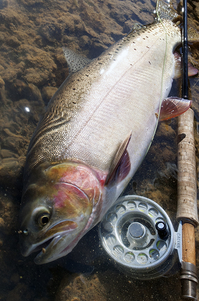
Fisheries managers have taken a very aggressive approach in an effort to keep the lake trout population of Yellowstone Lake in check. Using GPS and electronic tracking they have learned where these fish spawn and that’s where they have focused their attack. It’s working. The latest data indicates that this effort is paying off. This week the Idaho Statesman in Boise published a report with the latest data http://www.idahostatesman.com/news/state/idaho/article48308350.html
This kind of stuff is always controversial. There are those who want to keep lake trout in Yellowstone Lake. I’m definitely not one of them. I applaud the park’s efforts to resolve this challenge. The Yellowstone Cutthroat Trout is our native fish. I grew up catching them. There has been talk of listing them on the endangered species list. I can’t comprehend the loss of this fishery. It can’t happen. We can’t allow it to happen.
After I landed my fish I looked upstream and saw that the bison had moved to our side of the river and coming our way. It was time to move. We drove upstream where I fished a couple of other spots but didn’t land another fish. The days are short in October so we headed south. I fully understood it wasn’t prime time to fish the Yellowstone but I’ll be back. It opens again on July 15, 2016.